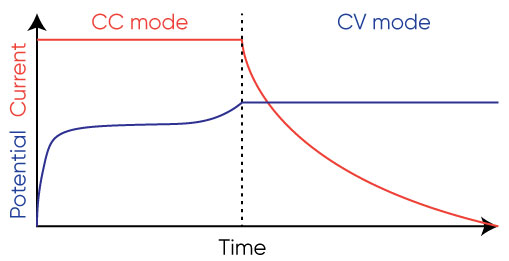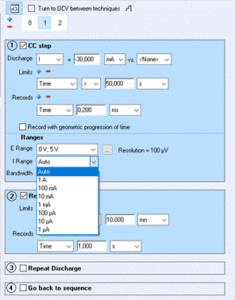Make life easier with smart limits and automatic I Range
Latest updated: June 28, 2023Introduction
In order to address the specific challenges associated with battery performance, it is essential to be able to have both controlled and adaptive current and voltage during experiments. Regulating current and voltage independently enables researchers to not only study battery materials, but also other applications, e.g., electrolysis or sensor applications. For more information on potentiostatic / galvanostatic modes, visit the article: What is a potentiostat and its use in Science & Industry
Often a combination of control techniques is needed to understand battery behavior under various operating conditions. For example, Constant Current Constant Voltage (CCCV) is a typical protocol on potentiostats, before the release of EC-Lab® V11.50 it was not possible to have auto-range in this technique making, this a first in the market. This technique mimics real-world charging scenarios by first applying a constant current to reach a specific state-of-charge, followed by a constant voltage stage, and helps define energy efficiency, charge acceptance, and voltage hysteresis.
Figure 1: Potential and current vs. Time in CC and CV mode
Modulo Bat (MB) is another technique specifically used in battery testing. Sequential combinations of galvanostatic and potentiostatic control simulate cyclic loading, partial charge-discharge scenarios in non-ideal operating conditions, for a better understanding of battery aging, capacity loss, and impedance changes.
These experiments can be difficult to set up and execute, and choosing the right values is important to obtain meaningful measurements and avoid noisy or inaccurate data. With EC-Lab® V11.50 software update release, these experiments are easier to run and adapt the hardware settings to the capacity of the device, allowing you to get the best from your instrument.
Automatic I Range
One of these new features includes automatic I Range in galvanostat mode. In order to utilize this feature simply open any galvanostatic technique on BioLogic’s Premium series instruments and select “Auto” from I Range dropdown menu (Fig. 2). Typically when running a battery through charge/discharge cycles, you would set a specific current but for battery applications this needs to be adaptive because it is dependent on the capacity of the device under test (DUT). The software can now optimize the current so you can perform charge/discharge cycles at different C-rates, over several current ranges, either on the same battery or a series of batteries with different capacities, all within the same technique.
Figure 2: Screenshot from EC-Lab®, where Auto I Range is selected
Smart charge limits
As a DUT is charged/discharged it degrades and over many cycles its capacity is diminished. This change in capacity is referred to as its State-of-Heath (SoH) and is important to take into account when testing batteries. A new feature introduced in EC-Lab® V11.50 (also available in BT-Lab software) for the MB technique allows you to define a charge limit, |Q|, as a function of the global charge accumulated during a specific step. There are several options to choose from including Q prev, which allows you to set the global limit based on the previous sequence and Q seq, for setting the limit to the charge of a specific sequence. This is a dynamic limit that adapts the discharge and charge limits to the exact capacity of the DUT measured with regards to a previously defined sequence of your test, preventing battery degradation due to over-charging or discharging.
Figure 3: Screenshot from EC-Lab®, where Q limit is selected
Conclusions
The introduction of features like automatic I Range and smart charge limits in the EC-Lab® V11.50 software update enhance the experimental capabilities by optimizing current for charge/discharge cycles at different C-rates and adapting dynamic charge limits based on the exact capacity of the device under test. These advancements simplify experiment set-up and mitigate battery degradation risks, enabling researchers to get the best performance from their instruments while testing battery behavior under various operating conditions. Updating your current EC-Lab to version 11.50 could not be easier and allows you to utilize these new features and many more. For more information, please visit the software update page.
Related products
Related accessories


